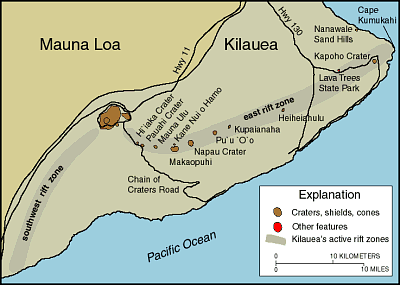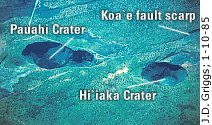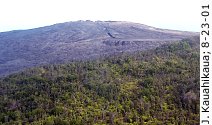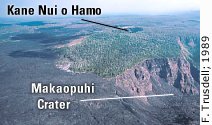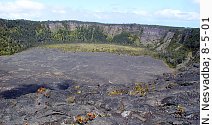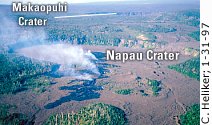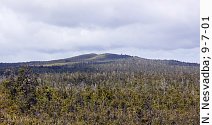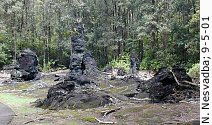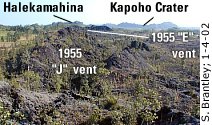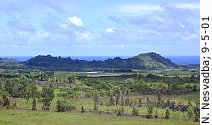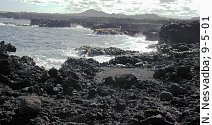
| |||||||||||||
|
Hi`iaka and Pauahi Craters
Hi`iaka Crater (the sisters of Pele) is a pit crater about 400 m wide and 90 m deep at the eastern end of a shallow collapse basin. Lava poured from fissures on the crater floor on 22 August 1968, forming a small lava lake that mostly drained away the same day. Again on 5 May 1973, fissures on the south crater wall, in the collapse basin, and southwest of the Chain of Craters Road sent lava into the crater. See 5 May 1973 eruption images and current view from the crater rim. Pauahi Crater (destroyed by fire) consists of three intersecting pit craters. The crater is about 650 m long at its top, nearly 400 m wide, and 110 m deep; the smallest crater is less than 150 m in diameter. Several fissures erupted inside and near Pauahi Crater during eruptions in May and November 1973 and November 1979. |
|
|
Mauna Ulu (growing mountain) The Mauna Ulu shield was built by many eruptive episodes during a five year period between 1969 and 1974. Until the eruption of Pu`u `O`o, this was the greatest outpouring of lava from the east rift zone in recorded history—about 350 million m3 of lava erupted from the vent, enough to fill 46 million average dump trucks. Today, still free of vegetation and standing 120 m above the surrounding ground, the shield is one of the most visible features from the Chain of Craters Road. This view of Mauna Ulu is toward the south; the east flank of Pu`u Huluhulu is in foreground. |
|
| Kane Nui o Hamo shield This prominent shield was built between about 400 and 750 years ago, probably over a period of several years. The tree-covered summit is marked by a large crater 300 m in diameter and about 60 m deep; the crater walls are near vertical. This view is toward the east. The cliff exposed on the south side of Kane Nui o Hamo is the north side of Makaopuhi Crater. |
||
|
Makaopuhi Crater (eye of the
eel) Makaopuhi Crater is a large crater 1.6 km by 1 km and 110 m deep—the largest pit crater on Kilauea. Before eruptions from Mauna Ulu sent lava into the crater, it consisted of two deep intersecting pit craters that collapsed sometime after the growth of the nearby Kane Nui o Hamo shield. The east pit crater formed first. It was partially filled by a lava lake, which had solidified when another pit crater collapsed just to the west. Before 1965, the west crater was about 300 m deep! An eruption in 1965 partly filled the west crater, but lava from the Mauna Ulu eruption filled the crater until it reached the level of the shallower east-pit crater. See Volcano Watch article about drilling into the 1965 lava lake. This view is toward the east. |
|
|
Napau Crater (the endings) A relatively young pit crater, Napau Crater is about 1 km in diameter and only 30 m deep. Ten eruptions have occurred from the crater in the past 200 years. During the most recent eruption in January 1997, fissures in and around the crater erupted about 300,000 m3 of lava, which partly covered the crater floor (see steaming fissure in photo); see monitoring results of this eruptive episode. This aerial view is toward the west-southwest; note Makaopuhi Crater in upper right. |
|
|
Pu`u `O`o cinder and
spatter cone (hill of the o`o, an extinct native bird) Pu`u `O`o is the main vent of the longest eruption from the east rift zone in at least the past 1,000 years. It is now the largest cone on Kilauea. Within 3 years of its first eruption in 1983, Pu`u `O`o reached a maximum height of 255 m above the former ground surface. Beginning in 1993, collapse pits began forming on the west flank. In early 1997, the entire west flank of the cone collapsed to form a large gap and a crater 210 m deep. Collapses continue to change the shape of Pu`u `O`o. More images of the collapse Pu`u `O`o. This aerial view is toward the west. |
|
|
Kupaianaha shield
(mysterious) In July 1986, the magma conduit below Pu`u `O`o ruptured, and the eruption shifted to a new vent, Kupaianaha, 3 km northeast of Pu`u `O`o. This marked the end of episodic high fountaining and the beginning of five-and-a-half years of nearly continuous, quiet effusion. A lava pond formed over the new vent, and its frequent overflows built a broad, low shield that reached its maximum height of 55 m in less than a year. This view toward the north shows the summit crater and axis of the lava tube (marked by collapse pits) through which lava moved from the vent to the sea during most of the time (see image of Kupaianaha filled with lava). Also, a panorama view of the summit crater is available: | med | large | |
|
|
Heiheiahulu Heiheiahulu is the only lava shield exposed in the lower east rift zone. Hawaiian oral history suggests that the shield formed during the first half of the 18th century. Early episodes of the eruption formed spatter ramparts along a 3.5-km-long segment of the rift zone and produced extensive `a`a flows. When activity became focused at Heiheiahulu, numerous lava flows built a shield, the longer ones advancing southward to the ocean between former Kaimu Bay (near Kalapana) and Kehena. The Heiheiahulu shield (522 m high) stands about 65 m above its surroundings and is indented by a crater less than 150 m long. This view is toward the west-southwest from a nameless 1955 cinder cone about 3.2 km from Heiheiahulu. See aerial views of Heiheiahulu and areas covered by lava flows of its eruption. |
|
|
Lava Trees State Park The lava trees in this park were formed during a small eruption in the late 18th century. A fissure near the park entrance—one of the early vents of the eruption—has drainback features formed when some of the lava poured back into the fissure at the end of the eruption, a process typical of fissure eruptions. The drainback lowered the original flow surface, exhuming the lava-covered tree trunks that now stand above the flow. Tree molds are also abundant in the park. |
|
|
1955 fissures open in cane fields Fifty-four hours after the first outbreak of lava near Pu`u Honua`ula on 28 February 1955, a series of fissures began erupting 1.5-5 km downrift in fields of sugar cane. Lava from three main vents (two shown here) merged to feed an `a`a flow that spread east about 3 km. The flow stopped advancing about 800 m from the ocean when the vents became inactive on March 6. This view is toward the northeast from the middle of vent "J," one of the three main 1955 vents along this part of the east rift zone. Highway 132 cuts between the two vents in the photo. |
|
|
Kapoho Crater (the depression) A series of strong explosions resulting from the interaction of ground water and magma formed this horseshoe-shaped cone. Deposits in the cone consist of many beds of broken rocks derived from new magma and from lava flows erupted earlier; intrusive rock fragments (gabbro) carried up from depth by the magma can also be found. The main crater floor consists of four small craters (not visible in this image), one of which is filled with water to form Green Lake. The cone rises about 110 m above its surroundings. It apparently formed some time between about 400 and 200 years ago. Kapoho Crater is a tuff cone, a rimmed volcanic structure surrounding a crater and built by magma-water interactions that explode new lava and a few older rocks. This view is toward the northeast, with the ocean behind. |
|
|
Cape Kumukahi (name given to
several persons from Hawaiian folklore; also "first beginning") This easternmost spot of the Island of Hawai`i (and of the Hawaiian Island chain) marks the place where Kilauea`s east rift zone meets the sea. From here, the rift zone continues eastward under water for another 55 km and reaches a depth of 5 km. The submarine part of the east rift zone is known as the Puna Ridge. Cape Kumukahi is formed by pahoehoe and `a`a flows that are several hundred years old. The cape was spared from the 1960 lava flow that covered much of the area (see map of 1960 flows). |
|
U.S. Department of the Interior, U.S. Geological Survey,
Menlo Park, California, USA
URL http://hvo.wr.usgs.gov/gallery/kilauea/erz/main.html
Contact: hvowebmaster@usgs.gov
| USGS
Privacy Statement | USGS
Disclaimer | Accessibility
|
Last modification: Monday, 10-Jun-2002 17:05:14 EDT
(pnf)
